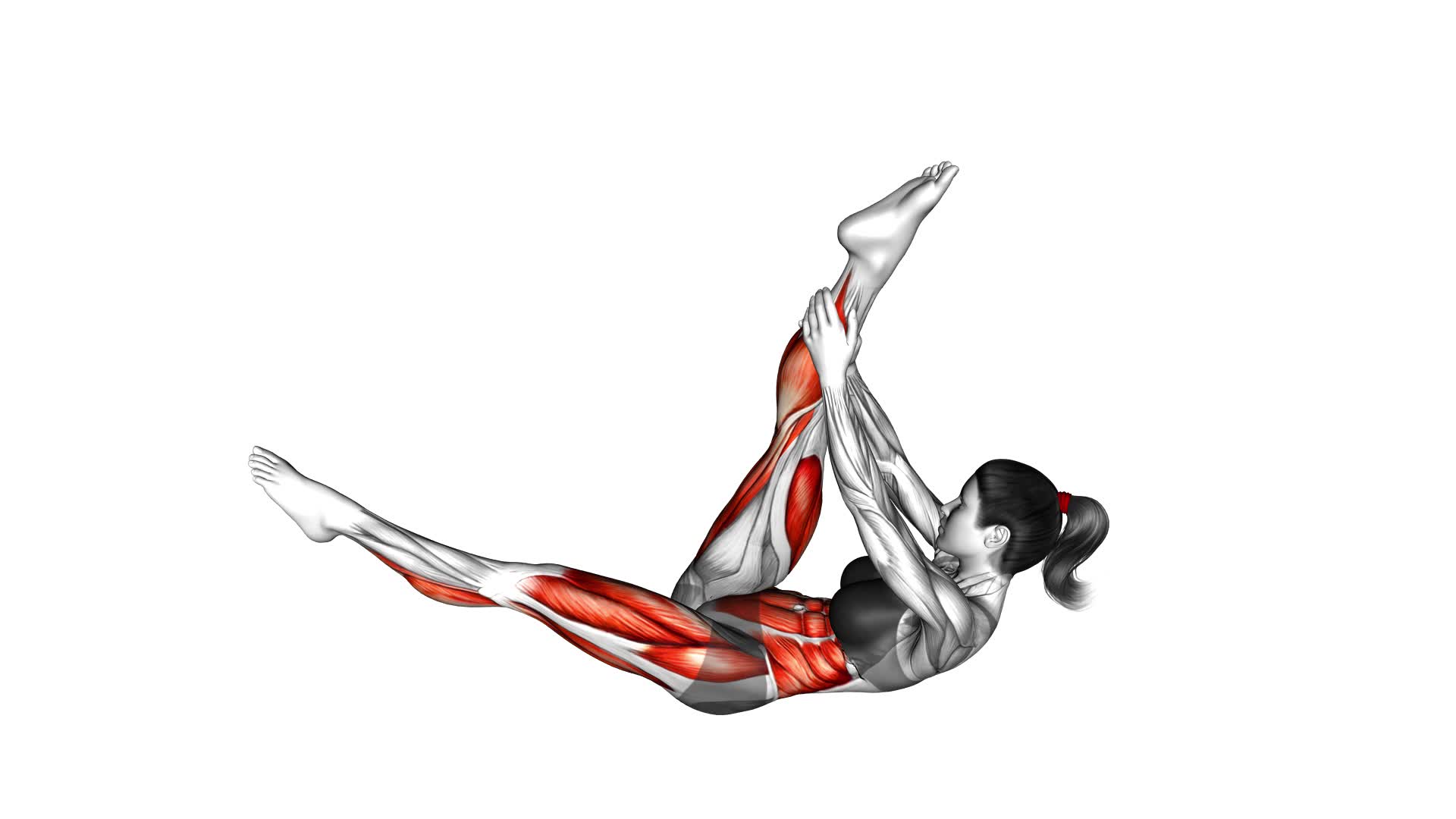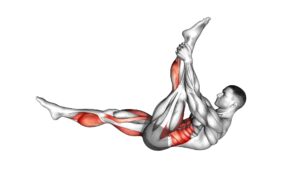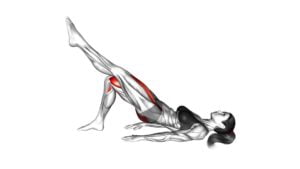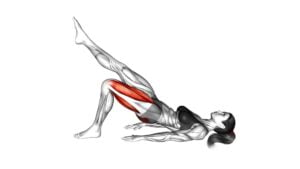Single Straight Leg Stretch (female) – Video Exercise Guide & Tips

Are you looking to strengthen your core and improve flexibility?
Watch This Exercise Video
The Single Straight Leg Stretch (female) is the perfect exercise for you! In this video exercise guide, you'll learn the proper form and technique to maximize your results.
Whether you're a beginner or advanced, there are modifications to suit your fitness level. Avoid common mistakes and minimize the risk of injuries with our expert tips.
Challenge yourself further with variations and progressions.
Get ready to take your fitness to the next level!
Key Takeaways
- The Single Straight Leg Stretch exercise improves flexibility, strengthens leg muscles, and targets core muscles.
- Proper form and technique include lying on your back, lifting one leg towards the ceiling, engaging core muscles, and controlling the descent of the leg.
- Beginners can modify the exercise by bending their knees slightly and placing their hands behind their head, while advanced levels can extend their legs lower or add ankle weights.
- Proper alignment and breathing techniques are important for stability, injury prevention, and maximizing results.
Benefits of the Single Straight Leg Stretch (female)
By performing the Single Straight Leg Stretch (female), you can improve your flexibility and strengthen the muscles in your legs. This exercise is particularly beneficial for female fitness, as it targets the core muscles and helps to enhance core strength. The Single Straight Leg Stretch engages the abdominal muscles, including the rectus abdominis and obliques, as well as the hip flexors and quadriceps.
This exercise requires lying on your back with your legs extended and your hands resting on the sides of your body. Begin by lifting one leg towards the ceiling, keeping it straight and engaging the core muscles to support the movement. As you lower the leg, use your abdominal muscles to control the descent and prevent any swinging or dropping of the leg. Repeat the movement with the opposite leg.
Proper Form and Technique for the Exercise
To perform the Single Straight Leg Stretch (female) exercise correctly, you should use a specific technique and maintain proper form throughout. This won't only help you avoid injury but also maximize your results.
First, let's focus on the technique. Start by lying flat on your back with your legs extended straight up towards the ceiling. Keep your arms by your sides, palms facing down. As you exhale, engage your core and lift your head, neck, and shoulders off the ground. At the same time, lower one leg towards the ground while keeping the other leg straight up. Inhale as you switch legs, maintaining control and stability throughout the movement.
Now let's talk about breathing techniques. It's essential to coordinate your breath with the movement. Exhale as you lift your head, neck, and shoulders off the ground, and inhale as you switch legs. This rhythmic breathing pattern will help you maintain focus and control during the exercise.
To maximize your results, make sure to keep your core engaged and your lower back pressed into the mat at all times. This will help you target your abdominal muscles more effectively. Additionally, avoid jerky movements and maintain a slow and controlled pace throughout the exercise.
Modifications for Beginners and Advanced Levels
For beginners and advanced levels, modifying the Single Straight Leg Stretch (female) exercise can help tailor the intensity and challenge to individual fitness levels. Whether you're just starting out or looking to take your workout to the next level, here are some modifications to consider:
- Beginner modifications:
If you're new to this exercise, you can start by bending your knees slightly instead of keeping your legs straight. This will reduce the strain on your lower back and make it easier to maintain proper form. Additionally, you can place your hands behind your head for added support and stability.
- Advanced modifications:
For those who are more experienced and looking for an extra challenge, you can try extending your legs lower to the ground while keeping them straight. This will engage your core muscles even more and increase the difficulty of the exercise. Another option is to add ankle weights or hold a dumbbell between your feet to increase the resistance and intensity.
Common Mistakes to Avoid While Performing the Exercise
To ensure proper form during the Single Straight Leg Stretch exercise, it's important to focus on alignment. Keep your shoulders relaxed and away from your ears, engage your core, and maintain a neutral spine.
Additionally, pay attention to your breathing techniques to enhance stability and control throughout the exercise. Remember to inhale deeply through your nose and exhale fully through your mouth, coordinating your breath with each movement.
Alignment for Proper Form
Ensure that you maintain proper alignment throughout the Single Straight Leg Stretch exercise by keeping your legs and torso in a straight line. Alignment is of utmost importance during this exercise as it ensures effective muscle engagement and prevents strain or injury.
Here are some common alignment mistakes to avoid:
- Avoid rounding your back or hunching your shoulders, as this can strain your spine.
- Keep your neck relaxed and in line with your spine, avoiding any forward or backward tilting.
- Engage your core muscles to stabilize your pelvis and prevent excessive arching of the lower back.
- Ensure that your legs are straight and aligned with your hips, avoiding any outward or inward rotation.
- Keep your shoulders down and away from your ears, maintaining a relaxed and open chest.
By maintaining proper alignment, you can maximize the benefits of the Single Straight Leg Stretch exercise and minimize the risk of injury.
Now, let's move on to the next section about breathing techniques for stability.
Breathing Techniques for Stability
Now let's focus on how you can use proper breathing techniques to maintain stability during the Single Straight Leg Stretch exercise.
Breathing techniques play a crucial role in enhancing core stability and overall performance.
When performing the Single Straight Leg Stretch, it's important to coordinate your breath with the movements to optimize stability and control.
As you exhale, engage your deep abdominal muscles, also known as the transverse abdominis, to stabilize your core. This contraction of the core muscles helps to support your spine and maintain proper alignment throughout the exercise.
Inhale deeply as you prepare for the next movement and exhale as you execute it.
Remember to avoid shallow breathing and focus on deep, diaphragmatic breaths to enhance stability and maximize the benefits of the Single Straight Leg Stretch exercise.
Tips for Maximizing Results and Avoiding Injuries
To maximize your results and prevent injuries during the Single Straight Leg Stretch exercise, it's crucial to focus on proper form. Maintaining a neutral spine, engaging your core muscles, and avoiding excessive strain on your neck and shoulders will help you perform the exercise safely and effectively.
Additionally, gradually progressing the difficulty and intensity of the exercise will allow your body to adapt and reduce the risk of overexertion or strain.
Proper Form Importance
Maintaining proper form is crucial for maximizing results and preventing injuries during the Single Straight Leg Stretch exercise. Proper alignment is essential to ensure that you engage the correct muscles and target the intended areas. Here are some benefits of maintaining proper form during this exercise:
- Increased effectiveness: When you maintain proper alignment, you activate the targeted muscles more effectively, allowing you to get the most out of each repetition.
- Injury prevention: Proper form helps to distribute the workload evenly throughout your body, reducing the risk of strain or injury to specific muscles or joints.
- Improved posture: By focusing on proper form, you develop better body awareness and strengthen your core, which can lead to improved posture over time.
- Enhanced balance and stability: Maintaining proper alignment during the Single Straight Leg Stretch helps to improve your balance and stability, increasing your overall control and coordination.
- Long-term progress: Consistently practicing proper form not only maximizes your results in the short term but also sets a solid foundation for long-term progress and success.
Gradual Progression for Safety
To maximize results and avoid injuries during the Single Straight Leg Stretch exercise, it's important to gradually progress and increase the intensity of your workouts. Gradual progression allows your body to adapt and strengthen over time, reducing the risk of overexertion or strain.
Safety should always be a top priority when engaging in any exercise routine. Start by mastering the basic form and technique of the Single Straight Leg Stretch before advancing to more challenging variations.
As you feel more comfortable and confident, gradually increase the number of repetitions or add resistance to your workouts. Remember to listen to your body and never push yourself too hard.
Variations and Progressions to Challenge Yourself Further
Challenge yourself further by incorporating these three variations and progressions into your Single Straight Leg Stretch workout routine.
- Increase the resistance: Use ankle weights or resistance bands to add extra resistance to your leg movements, making the exercise more challenging for your muscles.
- Add a twist: As you extend your legs out, twist your torso to one side, engaging your obliques and adding a rotational element to the exercise.
- Incorporate a stability ball: Place a stability ball between your legs and squeeze it as you perform the leg movements. This won't only challenge your leg muscles but also engage your core for greater stability and balance.
- Try a single-leg variation: Instead of using both legs, perform the exercise with one leg at a time. This will require more strength and stability from the supporting leg, intensifying the challenge.
- Speed it up: Increase the tempo of your leg movements, performing the exercise at a faster pace. This will elevate your heart rate and make the exercise more cardiovascular in nature.
Frequently Asked Questions
Can Men Also Perform the Single Straight Leg Stretch Exercise?
Yes, men can definitely perform the single straight leg stretch exercise. This exercise isn't limited to women and can be beneficial for men as well.
While the video may be labeled as 'female,' the exercise itself targets the core muscles, improves flexibility, and strengthens the legs.
Men can modify the exercise by adjusting the intensity or incorporating variations that suit their fitness level.
How Often Should I Incorporate the Single Straight Leg Stretch Exercise Into My Fitness Routine?
To determine how often you should incorporate the single straight leg stretch exercise into your fitness routine, consider your fitness level and goals.
As a general guideline, aim to perform this exercise 2-3 times per week. However, it's important to listen to your body and adjust the frequency accordingly.
If you're a beginner, start with fewer repetitions and gradually increase as you become more comfortable.
Additionally, remember to modify the exercise if needed to suit your individual needs and abilities.
Can the Single Straight Leg Stretch Exercise Help With Lower Back Pain?
The single straight leg stretch exercise can be beneficial for lower back pain. By engaging your core muscles and stretching your hamstrings, this exercise helps to improve overall flexibility and strengthen your back.
It's important to modify the exercise based on your fitness level. For beginners, you can start with bent knees or use a strap to assist in the stretch. As you progress, you can straighten your legs and increase the intensity.
Is It Necessary to Use Equipment or Can the Exercise Be Done Without Any Props?
To answer your question, equipment isn't necessary for the single straight leg stretch exercise. This exercise can be done without any props.
However, modifications can be made to make it more challenging or to accommodate any limitations you may have.
It's always important to listen to your body and make adjustments as needed.
Remember to consult with a fitness professional for personalized guidance and to ensure proper form and technique.
Are There Any Specific Breathing Techniques That Should Be Followed While Performing the Single Straight Leg Stretch Exercise?
When performing the single straight leg stretch, it's important to follow specific breathing techniques.
As you extend one leg out and draw the other knee towards your chest, exhale.
Then, inhale as you switch legs and repeat the movement.
This synchronized breathing helps to engage your core and control your movements.
Conclusion
Incorporating the single straight leg stretch into your exercise routine can provide numerous benefits for women. By maintaining proper form and technique, you can target your core muscles and improve flexibility.
Beginners can modify the exercise to suit their fitness level, while advanced individuals can challenge themselves with variations and progressions. Avoid common mistakes and follow the tips provided to maximize results and prevent injuries.
Stay motivated and enjoy the rewarding effects of this effective exercise.

Author
Years ago, the spark of my life’s passion ignited in my mind the moment I stepped into the local gym for the first time. The inaugural bead of perspiration, the initial endeavor, the very first surge of endorphins, and a sense of pride that washed over me post-workout marked the beginning of my deep-seated interest in strength sports, fitness, and sports nutrition. This very curiosity blossomed rapidly into a profound fascination, propelling me to earn a Master’s degree in Physical Education from the Academy of Physical Education in Krakow, followed by a Sports Manager diploma from the Jagiellonian University. My journey of growth led me to gain more specialized qualifications, such as being a certified personal trainer with a focus on sports dietetics, a lifeguard, and an instructor for wellness and corrective gymnastics. Theoretical knowledge paired seamlessly with practical experience, reinforcing my belief that the transformation of individuals under my guidance was also a reflection of my personal growth. This belief holds true even today. Each day, I strive to push the boundaries and explore new realms. These realms gently elevate me to greater heights. The unique combination of passion for my field and the continuous quest for growth fuels my drive to break new ground.



